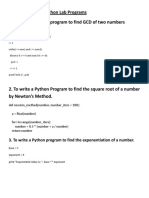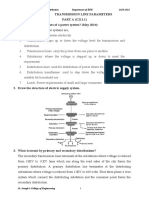Week-3 Python Lab Programs
Uploaded by
udaysaikiransrimanthulaWeek-3 Python Lab Programs
Uploaded by
udaysaikiransrimanthulaWEEK-3
1.
I) Write a program to convert a list and tuple into arrays
import numpy as np
#Declare List Elements
my_list = []
list_length = int(input("Enter No of List Elements:" ))
for i in range(list_length):
lst = int(input('Enter Element: '))
my_list.append(lst)
#Display List Elements
print("\n List Elements are: ",end=' ')
for i in my_list:
print(i,end=' ')
#Convert and Display Elements from List to Array
array1=np.asarray(my_list)
print("\n Convert After list to array is : ",array1)
#Declare Tuple Elements
my_tuple = []
tuple_length = int(input("Enter No of List Elements:" ))
for i in range(tuple_length):
tpl = int(input('Enter Element: '))
my_tuple.append(tpl)
#Display List Elements
print("\n Tuple Elements are: ",end=' ')
for i in my_tuple:
print(i,end=' ')
#Convert and Display Elements from List to Array
array2=np.asarray(my_tuple)
print("\n Convert After list to array is : ",array2)
1.
II)Write a program to find common values between two arrays.
from numpy import *
#Declare Array1 Elements
arr1 = array([],int)
length_arr1 = int(input("Enter the number of values you want: "))
for i in range(length_arr1):
values1 =int(input("Element: "))
arr1 = append(arr1, values1)
#Display Array1 Elements
print(arr1)
#Declare Array 2 elements
arr2 = array([],int)
length_arr2 = int(input("Enter the number of values you want: "))
for i in range(length_arr2):
values2 =int(input("Element: "))
arr2 = append(arr2, values2)
#Display Array2 Elements
print(arr2)
#Display Common values between two arrays
common=intersect1d(arr1, arr2)
print("\n Common values between two arrays",common)
2. Write a function called gcd that takes parameters a and b and returns their greatest common divisor
Program-1
# Python code to demonstrate naive
# method to compute gcd ( recursion )
def gcd(a, b):
if(b == 0):
return a
else:
return gcd(b, a % b)
# Driver program to test above function
m = int(input("Enter a Number: "))
n = int(input("Enter b Number: "))
print("The gcd of {0} and {1} is : ".format(m,n),end=' ')
print(gcd(m, n))
Program-2
# Recursive function to return gcd of a and b
def gcd(a, b):
# Everything divides 0
if (a == 0):
return b
if (b == 0):
return a
# base case
if (a == b):
return a
# a is greater
if (a > b):
return gcd(a-b, b)
return gcd(a, b-a)
# Driver program to test above function
m = int(input ("Please, Enter the First Value: "))
n = int(input ("Please, Enter the Second Value: "))
if(gcd(m, n)):
print('GCD of', m, 'and', n, 'is', gcd(m, n))
else:
print('not found')
3. Write a function called palindrome that takes a string argument and returns True if it is a palindrome
and False otherwise.
Remember that you can use the built-in function len to check the length of a string.
#Declare a Function with palindrome with argument str
def palindrome(str):
#use built-in function len to check the length of a string
for i in range(0, int(len(str)/2)):
if str[i] != str[len(str)-i-1]:
return False
return True
# main function
s = input("Enter a String: ")
#call the function to check the string is palindrome or not
ans =palindrome(s)
print(s," is Palindrome:",end='')
if (ans):
print("TRUE ")
else:
print("FALSE")
You might also like
- Change Over Procedure From Wesco Supply To DG Supply and Vice Versa100% (3)Change Over Procedure From Wesco Supply To DG Supply and Vice Versa2 pages
- # Python3 Program To Swap First and Last Element of A ListNo ratings yet# Python3 Program To Swap First and Last Element of A List25 pages
- Python Lab Programs 1. To Write A Python Program To Find GCD of Two NumbersNo ratings yetPython Lab Programs 1. To Write A Python Program To Find GCD of Two Numbers12 pages
- # Initialising The Value of PI: 1. Write A Python Program To Find The Area and Perimeter of A CircleNo ratings yet# Initialising The Value of PI: 1. Write A Python Program To Find The Area and Perimeter of A Circle10 pages
- PYTHON LAB MANUAL Name: Jitendra Kumar Roll No.: 05035304421 Section: 2No ratings yetPYTHON LAB MANUAL Name: Jitendra Kumar Roll No.: 05035304421 Section: 220 pages
- Solution Python Programming Practical ListNo ratings yetSolution Python Programming Practical List36 pages
- ENROLLMENT NO.:-160280107033 PYTHON PROGRAMMING (2180711) : Be - Comp. - Sem-8 - Ldce PageNo ratings yetENROLLMENT NO.:-160280107033 PYTHON PROGRAMMING (2180711) : Be - Comp. - Sem-8 - Ldce Page23 pages
- Write A Program To Print Following Pyramid: 1) CodeNo ratings yetWrite A Program To Print Following Pyramid: 1) Code7 pages
- C Programming Important Codes - Jai PDFNo ratings yetC Programming Important Codes - Jai PDF13 pages
- Compute The Greatest Common Divisor and Least Common Multiple of Two IntegersNo ratings yetCompute The Greatest Common Divisor and Least Common Multiple of Two Integers26 pages
- School of Computer Engineering: Lab RecordsNo ratings yetSchool of Computer Engineering: Lab Records28 pages
- Lamaran Pustakawan - Agil CV - CompressedNo ratings yetLamaran Pustakawan - Agil CV - Compressed3 pages
- Rounding To The Nearest Ten and Hundred: Mathematics CurriculumNo ratings yetRounding To The Nearest Ten and Hundred: Mathematics Curriculum2 pages
- VHP Series Five L7044Gsi S5: 1900 BHP (1416 KWB) at 1200 RPMNo ratings yetVHP Series Five L7044Gsi S5: 1900 BHP (1416 KWB) at 1200 RPM2 pages
- September 3 Grades 6 ADM School Accomplishment ReportNo ratings yetSeptember 3 Grades 6 ADM School Accomplishment Report6 pages
- Natural Adabas - Week1 - Revised 10-Jan-2013No ratings yetNatural Adabas - Week1 - Revised 10-Jan-201325 pages
- Calculations - Inorganic Crystal StructureNo ratings yetCalculations - Inorganic Crystal Structure17 pages
- Motors With Smooth Surface: Intelligent Drivesystems, Worldwide ServicesNo ratings yetMotors With Smooth Surface: Intelligent Drivesystems, Worldwide Services24 pages
- Queer Bangkok 21st Century Markets, Media, and Rights by Peter JacksonNo ratings yetQueer Bangkok 21st Century Markets, Media, and Rights by Peter Jackson321 pages
- Unit I Transmission Line Parameters PART A (C211.1) 1. What Are The Components of A Power System? (May 2014)No ratings yetUnit I Transmission Line Parameters PART A (C211.1) 1. What Are The Components of A Power System? (May 2014)143 pages
- Solution Evidence There Seems To Be A Problem With93% (15)Solution Evidence There Seems To Be A Problem With2 pages
- Implementation of The NDIS in The Early Childhood Intervention Sector in NSW Final ReportNo ratings yetImplementation of The NDIS in The Early Childhood Intervention Sector in NSW Final Report135 pages
- Special Thermal Back Fill Material Surround For Better Performance of Ehv CablesNo ratings yetSpecial Thermal Back Fill Material Surround For Better Performance of Ehv Cables12 pages
- BAMBOE PHD Thesis Sven Mouton Final Version 29-11-21No ratings yetBAMBOE PHD Thesis Sven Mouton Final Version 29-11-21334 pages
- Change Over Procedure From Wesco Supply To DG Supply and Vice VersaChange Over Procedure From Wesco Supply To DG Supply and Vice Versa
- # Python3 Program To Swap First and Last Element of A List# Python3 Program To Swap First and Last Element of A List
- Python Lab Programs 1. To Write A Python Program To Find GCD of Two NumbersPython Lab Programs 1. To Write A Python Program To Find GCD of Two Numbers
- # Initialising The Value of PI: 1. Write A Python Program To Find The Area and Perimeter of A Circle# Initialising The Value of PI: 1. Write A Python Program To Find The Area and Perimeter of A Circle
- PYTHON LAB MANUAL Name: Jitendra Kumar Roll No.: 05035304421 Section: 2PYTHON LAB MANUAL Name: Jitendra Kumar Roll No.: 05035304421 Section: 2
- ENROLLMENT NO.:-160280107033 PYTHON PROGRAMMING (2180711) : Be - Comp. - Sem-8 - Ldce PageENROLLMENT NO.:-160280107033 PYTHON PROGRAMMING (2180711) : Be - Comp. - Sem-8 - Ldce Page
- Write A Program To Print Following Pyramid: 1) CodeWrite A Program To Print Following Pyramid: 1) Code
- Compute The Greatest Common Divisor and Least Common Multiple of Two IntegersCompute The Greatest Common Divisor and Least Common Multiple of Two Integers
- Rounding To The Nearest Ten and Hundred: Mathematics CurriculumRounding To The Nearest Ten and Hundred: Mathematics Curriculum
- VHP Series Five L7044Gsi S5: 1900 BHP (1416 KWB) at 1200 RPMVHP Series Five L7044Gsi S5: 1900 BHP (1416 KWB) at 1200 RPM
- September 3 Grades 6 ADM School Accomplishment ReportSeptember 3 Grades 6 ADM School Accomplishment Report
- Motors With Smooth Surface: Intelligent Drivesystems, Worldwide ServicesMotors With Smooth Surface: Intelligent Drivesystems, Worldwide Services
- Queer Bangkok 21st Century Markets, Media, and Rights by Peter JacksonQueer Bangkok 21st Century Markets, Media, and Rights by Peter Jackson
- Unit I Transmission Line Parameters PART A (C211.1) 1. What Are The Components of A Power System? (May 2014)Unit I Transmission Line Parameters PART A (C211.1) 1. What Are The Components of A Power System? (May 2014)
- Solution Evidence There Seems To Be A Problem WithSolution Evidence There Seems To Be A Problem With
- Implementation of The NDIS in The Early Childhood Intervention Sector in NSW Final ReportImplementation of The NDIS in The Early Childhood Intervention Sector in NSW Final Report
- Special Thermal Back Fill Material Surround For Better Performance of Ehv CablesSpecial Thermal Back Fill Material Surround For Better Performance of Ehv Cables
- BAMBOE PHD Thesis Sven Mouton Final Version 29-11-21BAMBOE PHD Thesis Sven Mouton Final Version 29-11-21

























































































